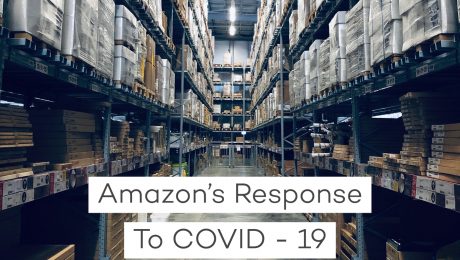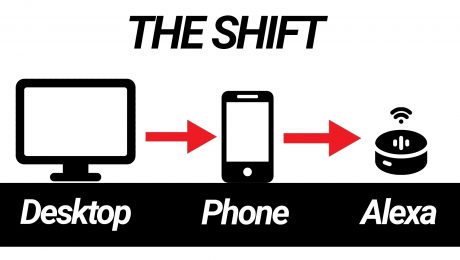Amazon Suspends FBA Shipments For Non-Essential Items In Response To Coronavirus COVID-19
According to Fulfillment by Amazon, the Coronavirus, also known as COVID-19, has been greatly impacting Amazon customers, sellers, and employees.
Since people are staying in their homes trying to prevent the COVID-19 from spreading any further, online shopping has increased dramatically leaving household items low in quantity or completely out of stock. Due to this dilemma, Amazon has chosen to temporarily prioritize household items such as staples, medical supplies, and other high demand products that have been entering their fulfillment centers in order to quickly obtain, restock, and deliver products to customers as fast as possible.
Amazon says that for any other products than these, they have temporarily disabled FBA shipments and they are taking a similar approach with retail vendors as well. This will be in effect until April 5th 2020. Amazon will communicate when they resume their regular operations. Any shipments created before March 17th 2020 will be received at Fulfillment centers. You can learn more about this on this Help page. It’s also important to note that Selling Partner Support does not presently have any further guidance.
Amazon understands how this change might impact our businesses and says how they most certainly did not take this decision lightly. They are working as hard as they can to increase capacity and are trying to quickly hire 100,000 new full and part-time positions at fulfillment centers across the US. They thank their Amazon customers, sellers, and employees for their understanding and patience as they prioritize the above products in response to COVID-19.
What Actions Could You Take?
- Consider increasing quantities on any pending orders by up to 5% without penalty
- Ensure that you have a back-up means of fulfilling inventory, such as your own warehouse or 3PL to do fulfillment. We advise all clients to create a duplicate SKU for each ASIN, one is used for FBA and one is merchant fulfilled or SFP. This is allowed by Amazon and is a good tactic to ensure sales momentum is not impacted greatly when you run out of stock in FBA. You should also be exploring alternative fulfillment to diversify into other channels such as Walmart, eBay and other marketplaces as a means of diversifying your sales revenue through multiple channels
- Consider adjusting your prices to maintain a run rate that does not run out of stock, but be careful not to increase prices too drastic or Amazon may suspend your buy box eligibility due to price gouging concerns
- If you have a regular cadence of planned inventory allocations to Amazon, you will want to account for this impact by increasing future shipments as needed
- Many sellers are seeing decreased sales of non-essential product sales recently, so you may find that additional inventory is not needed and this may be good to keep inventory balances in check
If you have questions about selling on Amazon, optimizing your listings and advertising campaigns to peak performance, please contact Prime Guidance for a free account consultation at info@primeguidance.com.
Author | Claudia Yates, Marketing Specialist
- Published in Other
Seller Central Headline News
Video Engagement Metrics:
Videos have always increased conversion rates on Amazon in Seller Central but now Amazon is finally revealing the metrics to support it. As of February 26, 2020, the viewership metrics for your videos are now available for viewing in the Video Management Library. Amazon sellers are able to track your views and review your engagement data in order to create influential content towards customer purchases.
Coming Soon:
Starting on March 15, 2020, Amazon will start requiring a long-term storage fee for inventory clean up. For further details, see FBA long-term storage fees. According to Amazon, “If you remove units of an ASIN that would be subject to long-term storage fees at the next inventory cleanup date, you won’t be able to send us more units of that ASIN for three months after that date. The exception is your inventory of that ASIN falls below our projection of its sales for the next eight weeks”
- Published in Other
Adapting for Growth of Voice Search On Amazon
Adapting for Growth
Large companies like Amazon and Google have constantly been making changes in how users interact with their platforms. As users continue to choose mobile over desktop, these companies must adapt. Google is making the desktop search results more and more like the mobile experience because of this shift of consumers migrating from desktop to mobile. The year of 2015 was the first year that mobile usage passed desktop usage.
This is important because, as advertisers and marketers, we need to adapt to the large shift that is occurring. People will always choose convenience over everything else and this is why Amazon is so successful with their large assortment and fast deliveries. Customers are now purchasing through Alexa’s and Google homes which means if you are not the #1 result, you will not capture sales through voice-activated purchases. This is why the brand is so important now.
Saying “Hey Alexa, order me soap”
is a lot different from …
“Hey Alexa, order me Dove Soap”
That brand name in the mix made an enormous difference because Amazon can pick who wins the “order me soap” but the customer decides when they say order me “dove soap”. The key to winning future sales is by increasing your brand awareness and consumer following. First, there was a huge shift from desktop to mobile, but now purchasing has been shifting toward voice searches, especially through voice-activated devices. Make sure your business thrives from these changes. Brand is more important than it ever. Grow your brand, Grow your business.
If you have questions about selling on Amazon, optimizing your listings and advertising campaigns to peak performance, please contact Prime Guidance for a free account consultation at info@primeguidance.com.
Author | Victor Dwyer, Marketing Specialist
- Published in Other
How to Speak Amazonian
The Amazon Language
As excited as I am about Google’s language translation technology, unfortunately it will not translate any language into Amazonian. Fortunately for all of us, there is no need to learn a different language. By remembering just a few key points, you will be able to master the Amazonian language very quickly. Having been an Amazon employee, it was very apparent that my success or failure was hinged onto my communication and fortunately I thrived.
Often when you are communicating with Amazon, whether verbally or in writing, there are typically two common reasons. One is just a simple, or maybe not so simple question while the other, which more often is the case, is because Amazon did something like deactivate an ASIN, possibly removed product ratings or something else that has impacted your business. Either way, when you speak Amazonian, you will have a much better chance of achieving the desired outcome. It is also important to remember that Amazon is a very data driven company, so stick to the facts and back up your points with data.
Two Lessons For You
If your reason for communicating with Amazon is the latter of the two, take a few minutes to prepare before you get into Amazon’s system to file a ticket or have them call you. The first thing I have learned when filing a trouble ticket, writing a business proposal or even a simple email is to “take out all of the emotion”, especially any frustration that you might have. The second lesson is to have the Amazon Leadership Principles guide every decision you make.In this case, there are two of them that are key to learning Amazonian. First and foremost is Customer Obsession and specifically, “Leaders start with the customer and work backwards”. Following that, the second is Insist on High Standards.
Amazon Thinking
When obsessing about a customer, you are ultimately considering the customer experience and how you can make it better. Amazon’s thinking is not “how can we sell this item or any other item to a customer”. It is “how can we make the customer experience so good and gain their trust that they want to come back again and again?”
Insisting on high standards should be self-evident and needs to start at the top. If the top level’s standards are only at 80% by the time the “plan” makes its way to group or person who will execute the plan, those standards are probably at 60% because those people have the attitude of “it’s good enough”. If the top levels have standards of 120% by the time they reach execution, they should at least be at 100%. If you are insistent, then they will still be at 120%.
So… what does all this have to do with speaking Amazonian? Again, there are two things to remember. You are playing in Amazon’s sandbox. No matter if something is right or wrong or if something is good or bad, it’s their rules. They have the biggest hammer. Secondly, all you should care about is your company’s bottom line and how you can make more sales, more profit, and grow the business. Now is the time to accept the rules and swallow your pride.
Example #1
As an example, let’s say Amazon deactivates one of your ASINs because you did not adhere to their requirements for the main image, which essentially says that it needs to be an image of the product only on a white background. It can’t typically be an “in use” or lifestyle image nor can it have any wording on it commonly called an infographic. Here are two examples of letters I have seen written.I will let you decide which one is written in Amazonian.
“Hi,
My ASIN B001234ABC was deactivated because of an image problem, but we chose this image because it really shows how the product works, why it’s better than all the competition and the sales will be much higher. There really is not a better way to show this product other than using this image first, mostly because a customer just seeing the product won’t get it nor will they buy it. Can you please reactivate the ASIN with the main image we uploaded?”
Or
“Hi,
ASIN B001234ABC was deactivated because the image shows the product in use rather than just showing the product on white background, which we understand it not the normal Amazon requirement. In this product category, often there is confusion about products. We did an extensive consumer study using “product only” images and “in-use” images. Not only did we find consumers liked the in-use image more, but more importantly, it led to virtually no product confusion making the purchasing experience that much better. There are products on the market, including some of our own that look similar, but have different functionality and having an “in-use” image first drove the return rate down considerably. The second image is of the product only and the resolution is higher than your requirements so consumers can easily magnify it to see important details.”
I am not saying that using the letter written in Amazonian will guarantee the outcome you want, but put yourself in the seat of the person reading the trouble ticket. If they are “Customer Obsessed”, thinking of the customer experience and having high standards, you have a much better chance receiving the desired outcome.
Example #2
Let’s look at another example of an ASIN being deactivated. However, this time it’s because of a quality issue and a consumer has accused you of selling a used product when it is listed as new. This is a good example of where it is easy to be frustrated and because you know the product is new, you also know it was packaged in such a way that it could not have been damaged in shipping. You are just confused on how this could happen. I have had clients who immediately assume that it’s a competitor trying to mess with their Seller Rating, which could be the case, however your first response to Amazon will often dictate the outcome, even before you propose a full solution.
Amazon’s ninth Leadership Principle, which I believe should be the second, is Bias For Action. Anytime a mission-critical issue arises and Amazon is the one to notify you, be sure to acknowledge it as soon as possible, even if you don’t have a full solution. Any good Seller is in their Seller Central account multiple times a day and should be aware of this kind of situation. Using the example above this would be my first response to Amazon, or how I would speak Amazonian.
“Hi,
ASIN B009876ZYX was deactivated within the last few hours due to a condition issue and although we know we only ship new goods, package them well and have the highest standards, we take this situation very seriously. As such we are immediately launching a full investigation and will return to you a Plan of Action (POA) in the next ## days (or hours if it is 48 or less).”
Those two sentences alone address six Leadership Principles: Customer Obsession, Ownership, Insist on High Standards, Bias for Action, Dive Deep and Deliver Results. Just make sure you are realistic in what you promise and deliver it in the time frame you set.
The Next Step
The next step will be writing the POA, which I won’t do in this blog, but it is an artform to be able to take responsibility for something without saying you did something wrong. However, this is significant only if you truly did not. If you find that you do have some kind of issue, such as using inadequate packaging material, then admit to the mistake and detail out how you have fixed the issue.
Finally, as I have already stated but want to reiterate, this is Amazon’s playground and they make the rules. Even if you don’t agree with them and can even prove them wrong, it’s important to treat Amazon as if they are still right. The Amazon employee you are working with to solve your issue may be able to bend them a bit, but he or she can’t change them. Speaking Amazonian may give them the backup they need (and can document) to rule in your favor.
If you have questions about selling on Amazon, optimizing your listings and advertising campaigns to peak performance, please contact Prime Guidance for a free account consultation at info@primeguidance.com.
Author | Robert Baron, Senior Consultant
- Published in Other
Strategically Thinking Beyond Amazon in 2020
The Current Landscape
The competitive landscape on Amazon is greater than it ever has been. If you are an authorized re-seller or an online retailer of various brands and products, you are dealing with an ever-increasing amount of legacy and traditional brands going direct to consumer.
These omnichannel moves by legacy brands was once prevalent only on their own D2C website, but over the last 5 years has rapidly increased on marketplaces such as Amazon and eBay.
Amazon private label sellers, some who pretend to be untouchable, are now faced with a formidable foe with the largest wave of Asian direct manufacturers, launching private label products on Amazon.com. Marketplace Pulse reported, in January of this year, that 49% of the top Amazon sellers are Chinese, while the U.S. has dropped to 47%.
Along with increased competition, these Asian sellers often employ “black hat” tactics to gain advantage in product rank and reviews, leaving U.S. merchants with few choices left except to increase ad spend and merchandising techniques.
Security Through Diversity
As much as I love Elon Musk dancing or his podcast interview with Joe Rogan, I would never put my entire IRA 100% allocated in Tesla. As much as no other marketplace or shopping engine can seem to match the might of Amazon, sellers and merchants must secure their future through diversity, just as you would with your investment portfolio.
Engage and expand on marketplaces such as:
- eBay
- Wal-Mart
- Target+
- Wayfair
- Google Shopping Actions
- Rakuten
- Wish
- Overstock
- Back Market
- Sears
- Jet
- TopHatter
Check out Channel Advisor’s List of Channels as inspiration:
Being involved in the ownership, management, and operations of over a dozen multi-channel e-commerce retailers over the last decade, I have found that almost 100% of the time secondary marketplaces were more profitable than the #1 sales channel. Analytical data points on financial statements such as return %, marketplace fees, and advertising as a % of sales were almost always higher on Amazon.com, sometimes even double, that of secondary channels.
Building a business through these secondary channels can be done, but it requires a different strategy than Amazon and employing the usual strategies or pretending like it’s a mini-Amazon is never successful.
What To Really Do
Before the world of selling goods revolved around 5-star ratings and info graphics, business was done by merchandising and relationships.
While analytical strategies such as page rank, reviews, images, video are still extremely vital on any channel outside of Amazon, these secondary marketplaces require daily attention by someone in your company that cannot be replicated by some automated software or cheap virtual assistant.
In my experience, relationships, in person meetings, dinners, etc. are also extremely vital to representatives from companies mentioned above. A lot of the decision makers and representatives from these companies are open to having monthly or weekly calls with you and your team members to create a roadmap to success.
Unique marketing opportunities often present themselves as well, such as, but not limited to:
- Daily deals
- Front page or category page placement for your business and/or select merchandise
- In app marketing
- E-mail marketing
- Ability to advertise products through affiliate channels
After that, it requires a well-trained team that understands each marketplace in depth, deploying and testing multiple strategies and then continuing to work on improving sales performance across each site.
If you have questions about selling on Amazon, optimizing your listings and advertising campaigns to peak performance, please contact Prime Guidance for a free account consultation at info@primeguidance.com.
Author | Matt Kubancik, Direct of Partnerships and Senior Consultant
- Published in Other





